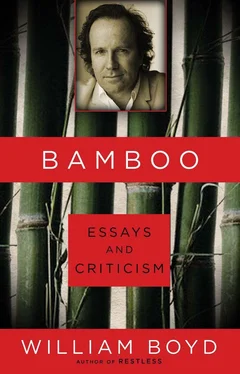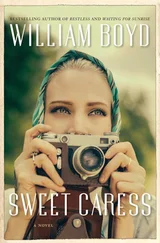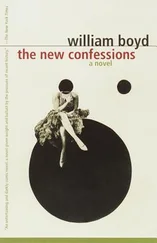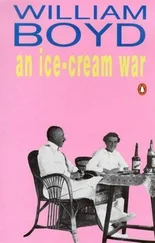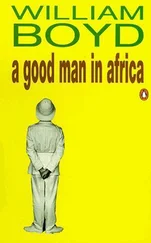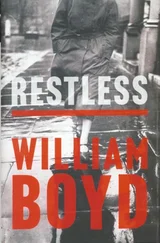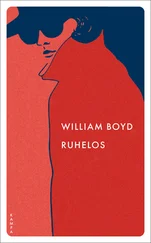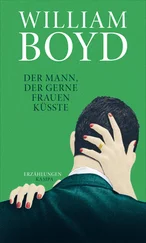Those early Palmeresque etchings of Sutherland, with the whole frame filled, dark with the precise scribble of cross-hatching, possess an assurance and mastery of technique that are mightily impressive. Inch by square inch the trees and the hills and the sky are rendered with the needle. The plate is immersed in the acid bath and the exposed metal eroded—“bitten”—according to the artist’s judgement: just a scratch here, the merest graze, here biting deeper, a scar, a furrow formed to hold the ink in a darker seam. But in the final process of etching, luck and experience apply: too many factors are at work — temperature, acid strength, character of the lines — to make for certainty. It is a job to be done indoors in an atmosphere redolent of the workshop rather than the studio. Perhaps this was something Sutherland responded to or even welcomed? He left school at sixteen and was apprenticed to the Midland Railway Works in Derby, where he worked with lathes and rivets, and welded plates to boilers for steam engines, before he quit the industrial world for Goldsmiths School of Art to specialize in printmaking.
Imagine, then, the almost terrifying freedom and immediacy of outdoors after the deliberate procedures of the print room — from the acid bath to the messy application of watercolour, from the permanency of the etched line to the rapid transit of pencil over a sketch pad balanced on your knee. Sutherland clearly responded to nature, as the faintly cod and cosy pastoral of those early etchings demonstrates, but the evident passion of the Pembrokeshire gouaches and oils in the mid 1930s testifies to a deeper liberation. This was not simply a numinous identification with landscape. There is — paradoxically — in that uncertain tremulous line of Sutherland, a liberation of technique. It is as if he cannot believe that the horizons have receded, that the light in the atmosphere is not produced by an electric bulb. Just as the lifer, once released, once through the prison gates, is more likely to savour the demotic pleasures of a coffee in a greasy spoon rather than embark on a holiday in Bali, so too Sutherland’s new freedom never goes all out for the full Romantic orgasm. The focus is precise: the entrance to a lane, the stark contortions of a blasted tree, the prickly grip of gorse on a sea wall. This is not a Turneresque visitation of the egotistical sublime, it is an altogether more cautious feeling-out, a tentative survey of new possibilities, new geometries, new worlds.
The artistic process reflects this exactly. First comes the raw exposure to the subject matter: the roving eye waits to alight on something, anything, that holds it — stone, rock, fissure, fall of water, bole of tree — and the sketch is made on the spot. Then possibly a series of sketches from different angles. A colour wash is added. Back in the studio a selection is made and is then squared up for copying and placing in the frame of the finished canvas. Wordsworth defined poetry as “emotion recollected in tranquillity,” and Sutherland’s working practice partially replicates this. But there is something dogged about the way the initial serendipitous coup d’oeil is worked up and worked on until its fitness as the subject of a painting is deemed suitable. Patience, thoroughness, endless practice, precision … These are the virtues of the etcher’s craft, and Sutherland transported them to his painting. Keith Vaughan testifies to the example Sutherland presented to a younger painter — the sheer number of hours he spent at work, its relentless daily routine. For those artists who rely on easy afflatus, or a facile or natural talent, or happy accident, a painter such as Sutherland can seem dauntingly intense and an almost shaming rebuke. Everyone else begins to look lazy, an amateur.
Sutherland was born in Streatham in 1903, his family and upbringing redoubtably middle class. He was a day boy at Epsom College (as was John Piper, by uncanny coincidence) which he left early — not deemed intelligent enough to continue to tertiary education — and was pointed at that dependable middle-class career, engineering. Whatever it was that made him want to go to art school and chuck his engineering apprenticeship was probably the saving of him, for there was no precocious talent on offer, no bohemian role model that made him hanker for life as an artist. He was handsome and polite, with a diffident charm, and he married his first girlfriend, Kathleen, a sustaining and vitally important union that was to last to his death. In short, or in superficial terms, there was nothing extraordinary about Graham Sutherland except his vocation. Looking at the life and at the work one can see it as a series of unfoldings, of revelations. The apprentice engineer discovers he can draw, the student masters the technicalities of printmaking, then responds to the vision of Samuel Palmer, which leads him in turn to landscape, where his own vision supersedes and a new style and way of seeing are created.
Even with portrait painting this process repeats itself. An excellent rather than naturally brilliant draughtsman, Sutherland was reluctant to attempt a likeness, yet in relenting to pressure and undertaking a commission to paint Somerset Maugham he produced one of the great portraits of the twentieth century. And continued to do so in subsequent commissions. There is no braggadocio, no easy profligacy in the Picasso manner, no bludgeoning personality, saturnine or sensational. Simply, the work exists, a half century of extraordinary effort.
And at its back, at its root, is that evocative line, the Sutherland line, his style, worth considering in more detail. It is idiosyncratic, unflowing, full of pauses, changes of angle. Not feathery, not sinuous, but quite strong, supplemented by little dashes, dots, squiggles, overlays, hatchings. In the studies for the landscapes the broad ovals and rectangles of black or colour are embellished or bordered with a fritter of pencil or pen marks, small circles, a series of curves to suggest the contoured bark of a tree, nervy shadings or meticulous renderings of the texture of lichen, or the rutted imprints of a country road. These leaves from the sketch pads are heavily worked between the broader, smoother swathes of colour. The swift scratches of a pen — a suggestion of a furrowed field — fringe a wash of green; a freckling of leaf shapes separates two aqueous crescents of ochre; feathery strata, veins in rock, worm between rough squares of umber and aquamarine.
Who can say what it is about an artist’s style that engages? What it is precisely that one responds to? How it pleasures the eye? How does that particular hand wield its brush or pencil or stick of charcoal, and what causes it to make its marks upon the surface in that singular way? With Sutherland I would say that it is this contrast of fiddly penmanship — of the black, the ink or the paint — with the smoother mass of the colour-field. The worrying, jaggy, suggestive line sits against empty calmer surfaces of colour, the tension of the one counterposed by the translucency or the opacity of the other. I am almost convinced this is a matter of instinct — this is unlearned, this is simply how you do it — and it is in these manipulations of pigment that the artist’s quiddity resides. In Sutherland’s case a quick skim through the oeuvre reveals this trope, this strophe, again and again. It is there in Mountain Road with Boulder , 1940, in the thorn trees and thorn heads half a decade later, in the Standing Forms of the 1950s, and the insects and corn cobs of the sixties and seventies. Any sketch, any gouache reveals that this tension, this contrast, is what his eye and his imagination respond to. Even the portraits are a variation of the same theme. The details of the face and clothing set against the broad empty panels of colour that form the background play with the same fecund juxtapositions.
Читать дальше
